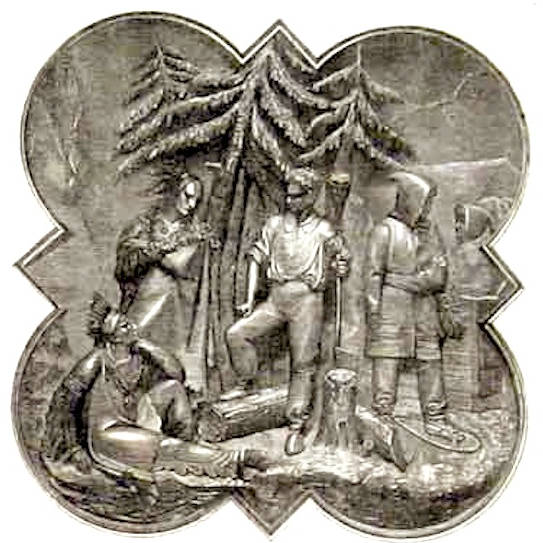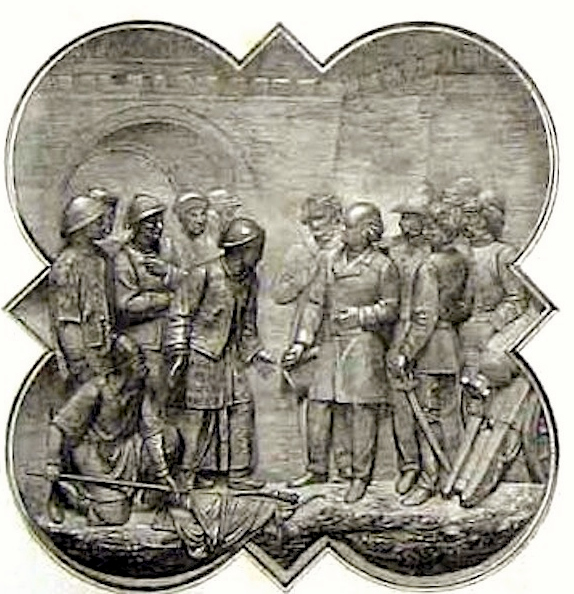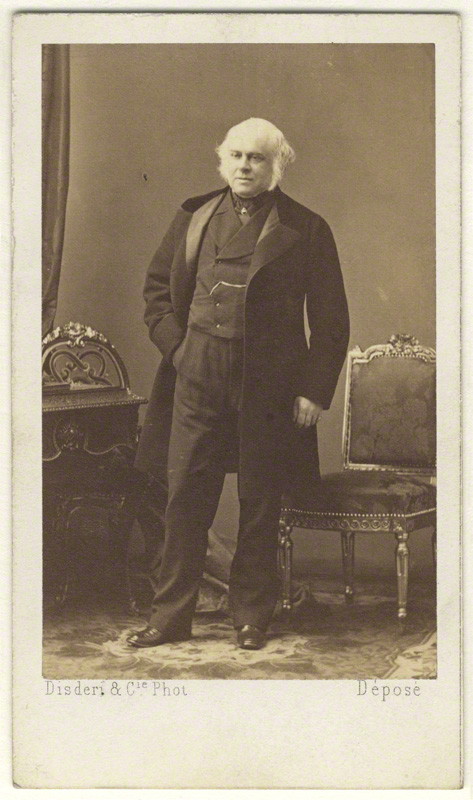The Design


This unusual monument to Lord Elgin (1811-1863), Viceroy of India 1862-63, is more significant than at first appears. Raised in memory of a tragically foreshortened Viceroyship, it was a project of the British Raj, and is one of several important monuments in the vestibule or narthex of St Paul's Cathedral, Kolkata, including a somewhat similar one to Colonel Richard Baird Smith. Both monuments resulted from the fruitful collaboration between George Gilbert Scott (later Sir George Gilbert Scott, 1811-1878) as designer, and John Birnie Philip (1824-1875) as craftsman in mixed materials. Both take the form of a tomb-chest or cenotaph with an inlaid brass cross and a Gothic canopy with a marble portrait at the top. This one to Lord Elgin, coming less than a couple of years after Colonel Smith's, was completed in 1869: models of its four bronze bas-reliefs were exhibited at the Royal Academy in that year ("Detail of Work"). It carries the Elgin motto "Fuimus" ("We Have Been" — meaning something like, "We Have Left our Mark").
To separate the work of designer and sculptor in such collaborations is to lose sight of the "robust synthesis" involved (Turnbull 28). This monument's significance, therefore, is twofold. On the one hand, it tells us much about Scott's artistic career at this time. In a lecture on Scott, fellow architect E. M. Barry once said that "Sir Gilbert Scott distrusted the introduction of principles of composition and details borrowed from abroad, and thus remained, as he began, an essentially English architect. The Albert Memorial in Hyde-park may be described as an exception to Sir Gilbert Scott's usual practice in this respect" (transcribed in Scott 383). However, this far smaller monument to Lord Elgin is another exception, suggesting that the whole scope of Scott's thinking was broader than Barry supposed. Secondly, the monument also speaks of the versatile skills of its craftsman. From 1852 onwards, Philip did a great deal of work for Scott. He is now best known as one of the sculptors involved in that grand enterprise in Kensington Gardens. But he had started out” by working for Pugin on the wood carvings for the Houses of Parliament, his commissions when he first set up on his own account had been for funerary and church monuments — and, most significantly, "Scott valued Philip's versatility in stone-carving and metalwork" (Stocker, emphasis added).
The Bas-Reliefs




The four bas-reliefs representing (left to right): (a) Jamaica. (b) Canada. (c) China. (d) India. These appeared in a feature on the memorial in an Illustrated London News issue of 1869.
Instead of the marble sculptured group that graces the monument to Colonel Smith, the Elgin monument features four matching bronze bas-reliefs in quatrefoils, in an elaborate studded surround. Each bas-relief represents one of the different places in which Lord Elgin had held high office. Jamaica shows a sugar-cane plantation, with a planter talking to his workers, while a young boy holds his horse. In the background, a woman carries a jug on her head. Canada shows a settler felling trees, with a Canadian Indian family to the left, and eskimos to the right. China is the only one to feature Elgin, who is evidently negotiating with a mandarin, with their respective men on each side, and a section of the Great Wall of China in the background. A Chinese man kneels on the right, unfurling the flag of China (according to Cotton 595) at their feet. India, significantly enough, shows a scene in an army camp, with a tent and an elephant in the background, sepoys at ease in the foreground, and Indians standing to the left and in the middle, in their several different forms of attire.
Here then, in the "sumptuousness of texture, colour and ornament, the enhanced role of metalwork, the blurring of the boundaries between architecture and sculpture, the incorporation of portraiture, and reliefs referring to four geographical continents or territories," not to mention his "ingenious engagement with Italian models" (Turnbull 28), are some important indications of Scott's wide interests at this time. Nor is this the only "exception" among Scott's very many works. His highly decorated chapel for King's College London (1864) is another example. It is fair to say that during the later sixties Scott was, in fact, continuing to explore "Italian Gothic and Byzantine architecture" and to harvest from it "the vocabulary of architectural ornament with which Ruskin had made him familiar" (Turnbull 27). Perhaps if he had had a freer rein in his designs, Scott might have been less "essentially English" than Barry claims, and than he now seems.
Lord Elgin


Left: James Bruce, Eighth Earl of Elgin, by Disdéri, © National Portrait Gallery. Albumen carte-de-visite, early 1860s, NPG Ax17296 — link opens in another window). Right: Lord Elgin's grave in Dhurmsala
A portrait in marble of James Bruce, Eighth Earl of Elgin, appears in the apex of the lower arch. It is rather small considering the size of the whole piece: "it hardly does Lord Elgin justice," comments an early guide to Calcutta (Cotton 595). But photographs suggest that it is an excellent likeness (see alongside). Elgin had died only about a year and a half into his new role as Viceroy. He was still touring and getting to know his new territories. He and his party were on the way to Peshawar on the North-West Frontier when the arduous journey became too much for him, and he died at the military station of Dhurmsala. He was buried in the graveyard of St John in the Wilderness Church at MacLeodganj, surmounted” by an impressive Gothic structure of its own. "He sleeps far away from his native land, on the heights of Dhurmsala; a fitting grave, let us rejoice to think, for the Viceroy of India, overlooking from its lofty height the vast expanse of the hill and plain of these mighty provinces — a fitting burial beneath the snow-clad Himalaya range, for one who dwelt with such serene satisfaction on all that was grand and beautiful in man and nature" (Walrond 467).
Related Material
- British India
- Monument to Colonel Baird Smith (1867) (an earlier collaboration between Scott and Philip)
Top two Photographs by the author. Photograph below right, of Lord Elgin's grave,” by Ipsita Banerji, who also provided the information about it. You may use these images without prior permission for any scholarly or educational purpose as long as you (1) credit the photographer and (2) link your document to this URL or cite it in a print one. Clearer illustrations of the bas-reliefs, from an 1869 edition of the Illustrated London News, were very generously provided by the antique prints and map dealers, www.old-print.com. The image of Lord Elgin's carte-de-visite was kindly provided by the National Portrait Gallery. [Click on the images to enlarge them.]
Bibliography
Checkland, Sydney. The Elgins, 1766-1917. Aberdeen: Aberdeen University Press, 1988 (p. 204 has a full-page picture of a replica of the memorial at the Elgin family seat, Broomhall House in Fife.)
Cotton, H. E. A. Calcutta Old and New: A Historical and Descriptive Handbook to the City. Calcutta: W. Newman & Co., 1907. Internet Archive. Web. 21 March 2014.
"Detail of Work." Henry Moore Institute. Web. 22 March 2014.
"John Birnie Philip." Mapping the Practice and Profession of Sculpture in Britain and Ireland, 1851-1951. Web. 21 March 2014.
Scott, Sir George Gilbert, R.A. Personal and Professional Recollections, edited by his son, G. Gilbert Scott, F.S.A.. London: Sampson Low, Marston, Searle, & Rivington, 1879. Internet Archive. Web. 21 March 2014.
Trumble, Angus. "Gilbert Scott's 'Bold and Beautiful Experiment,' Part II: The Tomb of Charlotte, Lady Canning." The Burlington Magazine. Vol. 142, No. 1162 (Jan., 2000): 20-28. Accessed via JSTOR. 21 March 2014.
Walrond, Theodore, ed. The Letters and Journals of James, Eighth Earl of Elgin. London: John Murray, 1872. Internet Archive. Web. 21 March 2014.
Last modified 25 March 2014